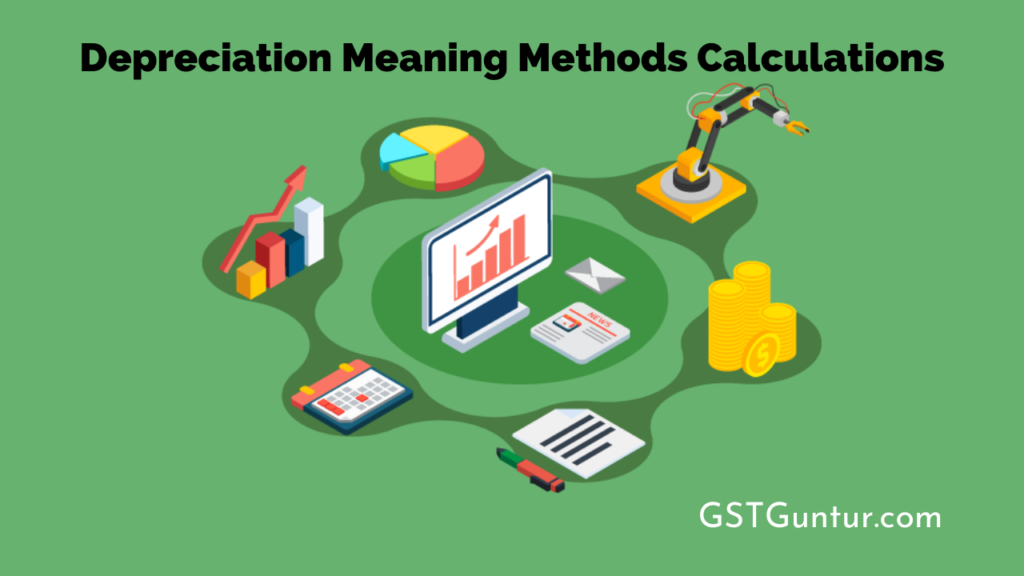Depreciation: In accounting, depreciation is the loss of a tangible asset’s monetary value over time due to use, wear and tear, or obsolescence. It’s an accounting method for allocating a portion of an asset’s cost to the profit and loss statement for a financial year over the asset’s useful life.
Simultaneously, the asset’s holding cost in the balance sheet is decreased to the same extent. Depreciation is a non-cash expense because it affects a company’s profitability without requiring a cash outflow. In this article, let’s understand what is depreciation, the formula and how it’s calculated in detail.
- Depreciation Definition
- Understanding Depreciation
- Depreciation Calculation
- Common Methods of Depreciation & Its Calculation
- Straight-line Method
- Straight Line Method Depreciation Formula
- Written Down Value Method (WDV)
- Formula To Calculate The WDV Depreciation
- Sum-of-years Digits Method
- Depreciation Annuity Method
- Why is Depreciation so Important?
- FAQ’s on Depreciation
Depreciation Definition
The monetary value of an asset decreases over time due to use, wear and tear or obsolescence. This decrease is measured as depreciation.
Understanding Depreciation
Depreciation is otherwise a loss in the value of an asset, that can be caused by n number of reasons such as bad market conditions Assets such as machinery, equipment, and currency are examples of assets that are expected to depreciate over time. Thus the depreciation is the opposite of appreciation, which is the growth in the value of an asset over time.
Usually, in accounting, we can calculate the depreciation of the assets based on information of asset life. Calculation or estimating the asses value is more important for the purpose of paying income taxes such as property taxes. Usually, the depreciation depends on the market or economic conditions.
Depreciation Calculation
There are multiple methods that are used to calculate depreciation. However, to calculate depreciation, one must first compute the depreciable basis. The depreciable base is the initial value to which the depreciation percentage is applied.
Depreciable base = (Cost of the Asset) – (Salvage or Residual Value at the End of its Useful Life)
Common Methods of Depreciation & Its Calculation
The types of Depreciation are explained in more detail below:
Straight-line Method
This is a straightforward technique of calculating depreciation in which a fixed percentage is applied to the depreciable base and the depreciation amount remains constant throughout the asset’s life until it is reduced to its salvage value. The percentage is calculated by dividing the asset’s depreciable base by its useful life in years.
Depreciation Straight Line Method Calculation Example:
If an asset costs one lakh and has a ten-year useful life with a salvage value of Rs. 10,000, depreciation is charged at Rs. 9,000 for each of the ten years.
which is:
Straight Line Method Depreciation Formula
Written Down Value Method (WDV)
The written down method is otherwise known as the reducing balance or diminishing balance method. A fixed rate of depreciation is applied to the reducing or diminishing value of the asset maintained in the books of accounts at the beginning of the financial period, rather than to the asset’s cost, under this method. The carrying value of the asset, as well as the annual depreciation, will be higher in the early years of this technique and will decrease as time goes on.
Depreciation Write Down Method Calculation Example
For example, If an asset is purchased for 1 Lakh and the depreciation rate is 10%, the first-year depreciation will be Rs. 10,000 which is 10% of Rs. 1,00,000, the second-year depreciation will be Rs. 9,000 which is 10% of Rs. 90,000, and the third year depreciation will be Rs. 8,100 which is 10% of Rs. 81,000.
Formula To Calculate The WDV Depreciation
where,
n = Remaining useful life of the asset (in years)
s = Scrap value at the end of the useful life of the asset
c= Cost of the asset/Written down value of the asset
Sum-of-years Digits Method
To calculate the depreciation rate, this method uses accelerated depreciation, which adds the years of the asset’s useful life. For example, f an asset has a five-year useful life, the total of the digits is 1+2+3+4+5=15. The depreciation for a given period will then be calculated using the asset’s remaining useful life years. As a result, the first year’s depreciation rate will be 5/15, the second year’s rate will be 4/15, and so on.
Depreciation Annuity Method
This method is not time-based, and it does not assess the useful life in years, but rather in terms of output capacity. The depreciation cost per unit for a production machine is calculated by dividing the entire cost of the machine by the total units manufactured by the machine over its lifetime. To calculate the total depreciation for the year, multiply this cost by the number of units manufactured during that time period.
Why is Depreciation so Important?
The depreciation is important because it provides various advantages which are listed below:
- Depreciation is a tax-deductible expense, so it’s crucial to think about it if you want to save money on taxes.
- According to the Companies Act of 2013, depreciation must be charged in the profit and loss account.
- If it isn’t taken into account, fixed-asset expenditures aren’t taken into account, and profit can appear to be quite high, especially in businesses that require a lot of plant and machinery. This may also result in a high distribution of earnings to shareholders, resulting in a lack of finances when the company needs to replace an asset.
FAQ’s on Depreciation
Question 1.
What are the 3 methods of depreciation?
Answer:
The 3 methods of depreciation are the Straight Line Method, Write Down Method and Sum of Years Digit Method.
Question 2.
What is the simplest depreciation method?
Answer:
The straight-line method is the simplest depreciation method.
Question 3.
On which assets depreciation is charged?
Answer:
The depreciation is charged only on fixed assets.
